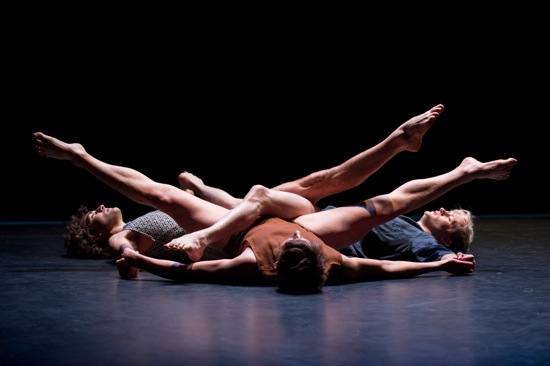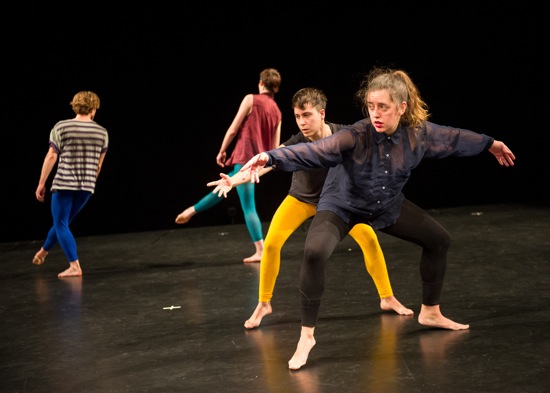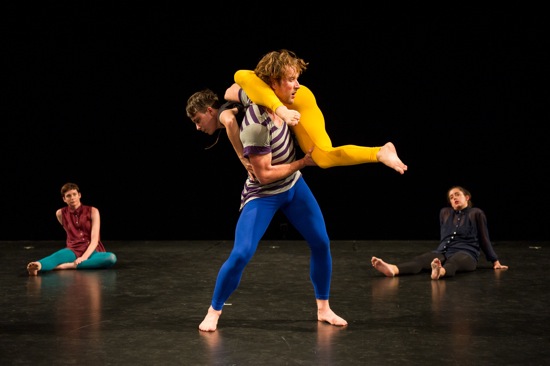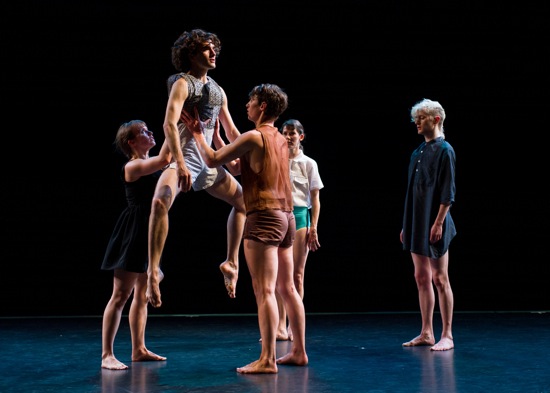
(L to R) Silas Riener, Michael Ingle, and Oisín Monaghan in Tere O’Connor’s Poem. Photo: Ian Douglas
Tere O’Connor has been making wonderful, inscrutable dances for 20 years, and every one of them that I can remember stirred my mind around. As I watch his new double bill at New York Live Arts, Secret Mary and Poem, my life passes before me. Delete “my;” I’m experiencing life as dancing—with its beauties, its collisions, its planned meetings, and its daily load of non sequiturs that somehow add up.
O’Connor is a master craftsman. He selects (or stumbles upon) movements that are not alike and makes them flow together. He tells no stories, although fleeting images might tempt you to make up your own. At least for a second or two. For O’Connor, as for Merce Cunningham, whom he counts as an influence, the movement and its structure arethe meaning. His dances have the semblance of something that’s being worked out in front of you, even though they’ve been meticulously and imaginatively constructed.

(L to R) Ryan Kelly, Mary Read, devynn emory, Tess Dworman in Tere O’Connor’s Secret Mary. Photo: Ian Douglas
Secret Mary is 32 minutes long and four performers dance it almost entirely in silence; Poem, with a cast of five, lasts for 42 minutes and has a score by James Baker for cello, guitar, and various other instruments. James Kidd created the informal, individual attire for both pieces, and Michael O’Connor lit both very elegantly. There’s no pause between the two dances. As Secret Mary winds down, Tess Dworman, devynn emory, Ryan Kelly, and Mary Read of Secret Mary begin leaping back and forth across the stage, and the cast members of Poem—Natalie Green, Michael Ingle, Oisín Monaghan, Heather Olson, and Silas Reiner—gradually infiltrate and replace them.
In both pieces, the dancers are wonderfully dissimilar. Some come out of modern dance, some out of ballet (Kelly danced with the New York City Ballet for four years). Riener is an alumnus of the Merce Cunningham Dance Company. emory is associated with Headlong Dance Theater. Olson has worked with O’Connor since 1997. All but one are choreographers themselves.

Ryan Kelly hoists devynn emory in Secret Mary. Mary Read (L) and Tess Dworman look on. Photo: Ian Douglas
O’Connor builds fields of activity in Secret Mary and Poem. Dancers feed into unison dancing or split into counterpoint, as if these were interesting activities they thought it might be fun to try. Sometimes they interrupt the flow of their movements, pause for thought or observation, then matter-of-factly delve into new material. The choices are eclectic. Shaking their heads may worthy of an effort, or facing away from us, sitting down, and arching back until the tops of their heads touch the floor and they’re looking at us upside down. Yet they also walk on tiptoe and launch themselves into what could be considered an easy-going classical cabriole.
In the beginning of Secret Mary, two beams of light career about NYLA’s performance space, while Dworman stands in a far corner, thrashing her arms around and the other three watch her. Alone, she investigates her flexible torso. Before long, All four have joined to side-step in a shallow ring, eyeing us steadily. Cause and effect, visible in some maneuvers (such as the wonderfully unwieldy back-and-forth lifts and manipulations by Kelly and emory), don’t seem to play a role in the larger picture. You don’t wonder why they lie in a tight circle and lift their legs into a bouquet; you may fleetingly think “Busby Berkeley” or “tired feet” or whatever strikes you, but just seeing the moment for itself is pleasure enough. Stuff happens. M. O’Connor plays similar games with light. You can interpret as you wish (or not) when he borders the stage with a line of light, defining the space the way white lines mark a tennis court.

Natalie Green and Michael Ingle lift Silas Riener in Poem. Heather Olson and Oisín Monaghan watch. Photo: Ian Douglas
Poem is different in ways I can’t quite grasp. For one thing, Baker’s music kicks with a variety of sounds as atmospheric as rain (or was that a train?), as poetic as plucked strings, as rattling as seed pods. The lighting warms and cools. The dancers seem to cover more space more frequently, to cooperate more. They move into a chain, a circle. But like the performers in Secret Mary, they watch one another closely, pick up an ongoing movement they like the look of (that’s the illusion anyway). Certain moments stick in my mind: people bending forward like drinking birds, or sinking very slowly into court curtseys, or clustering in a corner and distorting their bodies in weird ways. Riener and Ingle dance together—an adventure of slow lifts and counterbalances and serenely sensual tangling.
Watching the dancers in both pieces, I think what interesting people they are as their dancing selves. In O’Connor’s malleable little societies, they’re alert, peaceable, wily, and expert at capturing the changeable rhythms and energies that mark our days.

Lovely, lovely writing as usual, putting us in the audience with you, making us see what you see, and what you make of it with the clarity of what? A mountain stream? A crystal? Words fail me at the moment as they never seem to fail you. Many thanks Deborah.